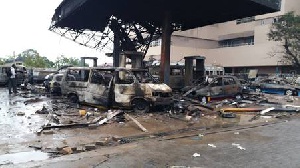A memo has surfaced indicating that the deadly Accra floods and fire disaster was predicted thirteen years ago.
The memo dated 15th May 2002 and authored by Seth Kpodovia who was a team leader that investigated Accra floods foretold that Ghana would experience the disaster if certain measures are not put in place.
“Other notable properties that will likely to be affected in the case of flood shall be the Kwame Nkrumah Circle, Ghana Commercial Bank Tower, Barclays Bank, the Entertainment spots, the filling station nearby may even catch fire destroying properties in and around the area. Note that the area is highly patronized day and night hence care must be taken to restore the sand trap,” portions of the memo reads after analysing the flood situation in the country.
Below is the full memo:
Confidential
Audit Observation Organisation: Ministry of Works and Housing
Ref: AD/2002/A1
To: Chief Director/CTA Water
From: Seth Kpodovia, Room 18, Team Leader
Date: 15/5/2002
Subject: Destruction Of Nima Sand Trap
I shall be very grateful for your comments on the following audit observations by 18th May 2002. Your comments should be duly signed and dated.
During review we observed that the government spent billions of cedis on excavation and desilting of various drains in Accra. The Ministry of Works and Housing is yet to pay the contractors for the rest of the work done.
We noted that last year 2001, various items such as household, industrial goods worth several billion cedis were destroyed by the flood.
During an inspection we observed that concrete lining of Odaw River in which the contractor used bags of sand to check the movement of the water for him to blind the floor, were not removed. As at today the bags are still lying in the drain (River).
With this, material or silt carried by the water will pile on them creating land and some geographical features. This will block the flow or free movement of the water stream.
Secondly, the floor of the concrete lining should have been “V” shaped and not flat.
The Odaw River in which most of the primary and secondary detains in Accra enter and discharge the water and flow into the sea must be desilted especially from Avernor circle. The contractors must remove the bags of sand packed in the river bed.
Thirdly, we noted that the Nima Sand Trap at Circle was destroyed through the concrete lining. The Nima Sand Trap at Kwame Nkrumah Circle near the Ghana Commercial Bank building. This sand trap and debris generated from Nima and its surrounding areas are trapped and distilled. Nima area generated more sand and debris than any other areas. The area is one of the flood prone areas. The Nima areas covers Mammobi, parts of New Town, Kokomlemle, Asylum Down, Circle, parts of Adabraka, Legon, parts of Roman Ridge, Airport areas etc.
With the destruction of Nima Sand Trap, Accra is in trouble. The debris cannot be trapped and distilled. The debris will choke and water cannot flow into the Odaw River. This also means the water will not flow into the Odaw River when those from the Upper course of odaw River are higher. In case there is high tide at the most of the Korle lagoon the water will not flow the Odaw into the sea.
With the above factors when the areas mentioned above get flooded, properties goods and lives will be lost. Hence several billions of cedis will be used on relief and rescue the inhabitants of this area. The sand and other material will also enter the Odaw which will be carried into the korle lagoon.
This will affect the KLERP hence loss of $66,000,000.000. Other notable properties that will likely to be affected in the case of flood shall be the Kwame Nkrumah Circle, Ghana Commercial Bank Tower, Barclays Bank, the Entertainment spots, the filling station nearby may even catch fire destroying properties in and around the area. Note that the area is highly patronized day and night hence care must be taken to restore the sand trap.
The senior Hydrologist of the Hydrological Service Department stated that they have informed the consultant on the project, but he has failed to listen to their advice, the project was undertaken by Ministry of Local Government and Rural Development. He continued and stated that this is the problem. They were much worried. This is the time the Hydrological Service Department must remove the sand from this Nima Sand Trap it is covered.
With this we recommend that the Minister and the Acting Chief Technical Advisor / Water should contact the Minister of Local Government and Rural Development so that this case is remedied as early as possible before the onset of the rain.
Secondly all drainages work undertaken by the Ministry of local Government and Rural Development in the city should be reviewed and supervised by the Hydrological Services Department.
The Senior Hydrologist agreed to this suggestion.
Otherwise in case of flood we shall surcharge the minister of Local Government and Rural Development and the consultant who supervised the project with any expenditure incurred and loss of property and lives.
As the Hydrological Services Department has earlier on stated elsewhere, the attention of the MLGRD has been drawn on several occasion to this problem and at the various meetings. Even the entry point of the Nima Drain to the Odaw is also problematic as it enters a topmost right angle to the main Odaw drain with its attendant backwater effect on the Nima Drains thus causing inundation of properties upstream.
All these issues have been raised with MLGRD through their Project directorate, which have overall supervision of the project. As to the geometry of the drain section, the device design has probably been based on hydraulic calculations.
THE Ministry through HSD will continue to impress upon the MLGRD the need to consult with HSD on issues relating to drainage and flood control measures.
General News of Friday, 26 June 2015
Source: The Insight Newspaper

















